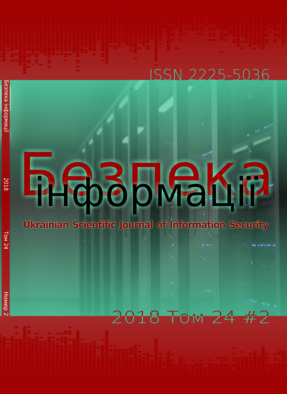Advanced hash function MD4
DOI:
https://doi.org/10.18372/2225-5036.24.12955Keywords:
cryptography, hash function, information integrity, information protection, cryptestabilityAbstract
Today information is seen as a strategic resource. Modification of the information or it’s illegal dissemination can lead to serious consequences. The process of ensuring information protection get’s complicated with the development of computing machines. The integrity of important operating system files, programs or data controled of hash function. Hashing is used to construct associative arrays and duplicate in a series of datasets, build unique identifiers for a set of data, with a view to determining the Checksumming accidental or deliberate errors in you save or transfer, to save passwords on systems of protection, in the formulation of an electronic signature. More recently, industry related cryptographic hash faced a significant challenge-sustainability to multikolizijam that use attack Zhuks. In his work Zhuks has shown that sustainability, calculates the hash value by cascading these functions, not much more than the stability of one of them. In addition, the known hash algorithms do not allow to fully address the issues of ensuring the durability and performance of cryptographic algorithms. Therefore, developing new and improving existing hash functions with a view to enhancing the effectiveness of cryptographic protection will not lose its relevance. With this in mind, in the work of the proposed hash function newMD4, which was developed on the basis of the original hash function MD4. Designed hash function newMD4 has several innovations compared to MD4: if you are compressing instead of four 32-bit variables proposed using five 64-bit variable increased the length of the hash value to 256-bits; replaced by additional functions added additional operations at each stage. In the work of the experimental research on the evaluation of Expressway and the statistical characteristics of the proposed hash function. Under the same conditions, conducted pilot studies to assess mental speed characteristics, which showed that the hash function newMD4 faster than the original MD4 in 1,43 times. For research of statistical characteristics of NIST tests were used in the STS, at the same hash function used to generate sequences, statistical characteristics of teristiki which tested the specified tests. According to the research results, consistency, using the hash function sgenerirovanye newMD4 showed better statistical characteristics compared to the original.References
Мухачева В.А., Хорошко В.А. Методы практической криптографии. К.: ООО «Полиграф Консалтинг», 2005, 215 с.
Хеш функції и цифрові підписи. URL: http://izi.vlsu.ru/teach/books/913/theory.html
Шнайер Б., Фергюсон Н. Практическая криптография. М: Диалектика, 2005, С. 105
Joux A. Multicollisions in Iterated Hash Functions. Application to Cascaded Constructions. URL: https://www.iacr.org/archive/crypto2004/31520306/multicollisions.pdf
Бондаренко В.В. Введение в криптографию : Учебное пособие. С: СГУ, 2000, С. 234
Rivest R., The MD4 Message-Digest Algorithm. URL: https://tools.ietf.org/html/rfc1320
Rivest R., The MD5 Message-Digest Algorithm. URL: https://www.ietf.org/rfc/rfc1321
Eastlake D., US Secure Hash Algorithm 1 (SHA1) URL: https://tools.ietf.org/html/rfc3174
Bider D., SHA-2 Data Integrity Verification for the Secure Shell (SSH) Transport Layer Protocol. URL: https://tools.ietf.org/html/rfc6668
V. Dolmatov. GOST R 34.11-2012: Hash Function. URL: https://tools.ietf.org/html/rfc6986
Keromytis A., The Use of HMAC- RIPEMD-160-96 within ESP and AH. URL: https://www.ietf.org/rfc/rfc2857.txt
S. Miyaguchi, K. Ohta, and M. Iwata (November 1990). "128-bit hash function (N-hash)". NTT Review. 2 (6): c. 128–132.
Eli Biham, Adi Shamir. Differential cryptanalysis of Snefru, Khafre, REDOC-II, LOKI and Lucifer (Extended Abstract).
Dobraunig Christoph, Analysis of the Kupyna-256 Hash Function. URL: https://eprint.iacr.org/2015/956.pdf

